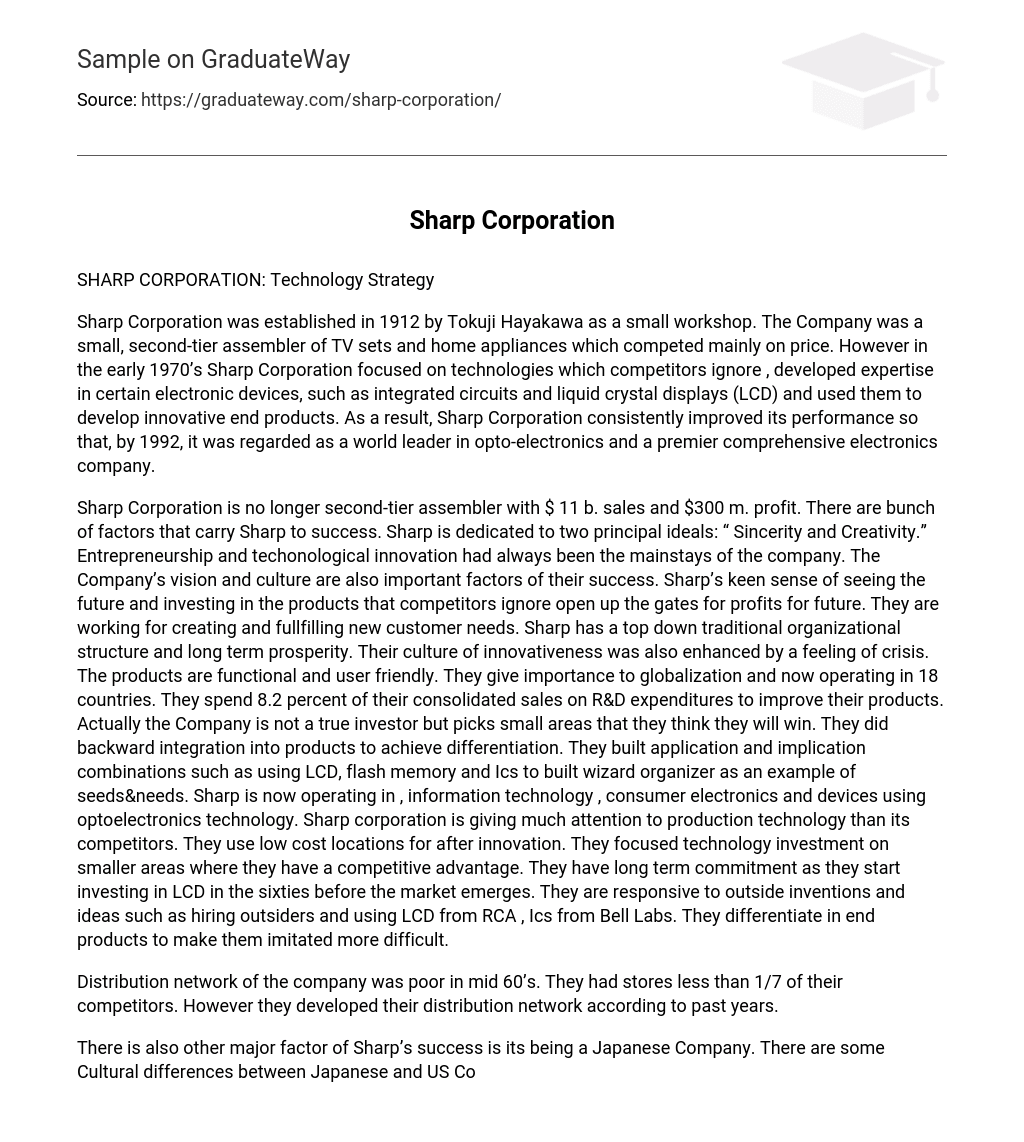SHARP CORPORATION: Technology Strategy
Sharp Corporation was established in 1912 by Tokuji Hayakawa as a small workshop. The Company was a small, second-tier assembler of TV sets and home appliances which competed mainly on price. However in the early 1970’s Sharp Corporation focused on technologies which competitors ignore , developed expertise in certain electronic devices, such as integrated circuits and liquid crystal displays (LCD) and used them to develop innovative end products. As a result, Sharp Corporation consistently improved its performance so that, by 1992, it was regarded as a world leader in opto-electronics and a premier comprehensive electronics company.
Sharp Corporation is no longer second-tier assembler with $ 11 b. sales and $300 m. profit. There are bunch of factors that carry Sharp to success. Sharp is dedicated to two principal ideals: “ Sincerity and Creativity.” Entrepreneurship and techonological innovation had always been the mainstays of the company. The Company’s vision and culture are also important factors of their success. Sharp’s keen sense of seeing the future and investing in the products that competitors ignore open up the gates for profits for future. They are working for creating and fullfilling new customer needs. Sharp has a top down traditional organizational structure and long term prosperity. Their culture of innovativeness was also enhanced by a feeling of crisis. The products are functional and user friendly. They give importance to globalization and now operating in 18 countries. They spend 8.2 percent of their consolidated sales on R&D expenditures to improve their products. Actually the Company is not a true investor but picks small areas that they think they will win. They did backward integration into products to achieve differentiation. They built application and implication combinations such as using LCD, flash memory and Ics to built wizard organizer as an example of seeds&needs. Sharp is now operating in , information technology , consumer electronics and devices using optoelectronics technology. Sharp corporation is giving much attention to production technology than its competitors. They use low cost locations for after innovation. They focused technology investment on smaller areas where they have a competitive advantage. They have long term commitment as they start investing in LCD in the sixties before the market emerges. They are responsive to outside inventions and ideas such as hiring outsiders and using LCD from RCA , Ics from Bell Labs. They differentiate in end products to make them imitated more difficult.
Distribution network of the company was poor in mid 60’s. They had stores less than 1/7 of their competitors. However they developed their distribution network according to past years.
There is also other major factor of Sharp’s success is its being a Japanese Company. There are some Cultural differences between Japanese and US Companies :
Cultural Differences Between Japanese and Americans Business
Low mutual dependence between employers and employees
Control of business by stockholders and the management
Heavy dependence on machinery and technology, vs. Light dependence on human resources
Limited loyalty and incentive-oriented work ethics
Excellent software-based technology development
Heavy dependence on human resources and teamwork
High mutual dependence between employers and employees
Joint management of business by Employees and Employees
Heavy dependence on human resources
Strong loyalty and fewer incentives
Inadequate software development ability
Sharp Corporation has top down traditional organizational structure which is functional and make things implemented quickly. They shared responsibilities among eight manufacturing groups, five sales and marketing groups, an international business group, a corporate research and development group, and a number of central service groups. All of these groups, except the International Business Group, reported directly to the five top managers. The manufacturing groups, the International Business group, and the sales and marketing groups were profit centers, while the corporate R&D group and central service groups were cost centers.
Sharp Corporation had a paternalistic relationship with its employees, and top management reinforced the view that the company was a family, or community, whose members should cooperate. Employee turnover was very low in accordance with the practice of life time employment. If a research project or a manufacturing plant closed, researchers and workers were not laid off but transferred elsewhere in the company. The rewards is on fitting in consensus and coordination.
Turning to the question of “Should Sharp enter into the Intel and Apple joint ventures ?” , my opinion will be positive about joint ventures. Because Intel has 85% of the flash memory market today and it is $ 130 m. market. Sharp should get flash memories from Intel to produce its own products requiring flash memories or to sell other companies. For example to build wizard organizer, the company needs flash memory and their products of LCDs , Ics and software. Also If Sharp enter into Apple Joint venture it can use these flash memories and their own LCDs to produce laptop computers and Apple’s software. Because the computer market is rapidly growing and profitable market.





